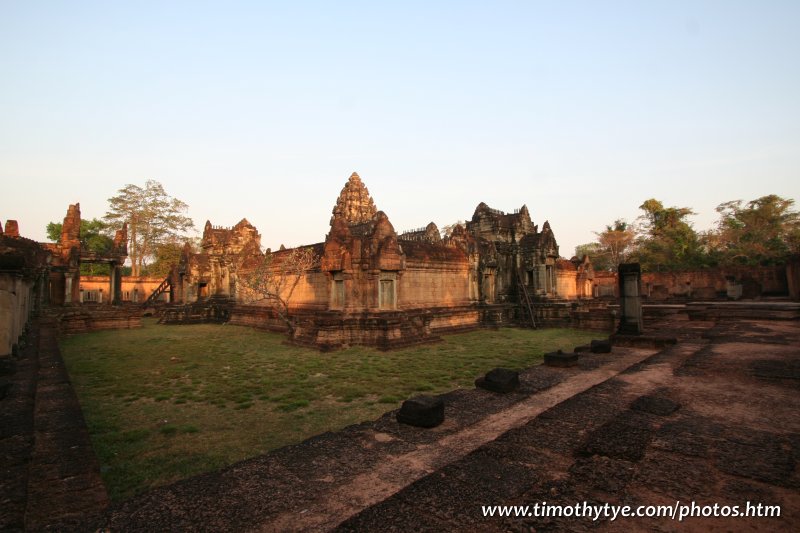 Banteay Samre (25 February, 2006)
Banteay Samre (25 February, 2006)
Banteay Samre ប្រាសាទបន្ទាយសំរែ (GPS: 13.44209, 103.9593) is a medium-size ruin located on the east side of Angkor, away from the rest of the monuments. Visitors usually combined an excursion here to a visit to Banteay Srei. However, as I discovered, although Banteay Samre is on the way to Banteay Srei, it isn't that far out, so I visited it together with the ruins of the Small Circuit, such as Ta Prohm and Thommanon. I know this is not the usual practise, but it works for me. As for Banteay Srei, I visited it combined with Kbal Spean.
Banteay Samre was built during the middle part of the 12th century. The present name was derived from a people called Samre who lived at the foot of Mount Kulen. The people living in the village of Pradak (which you'd pass on your way to Banteay Samre) are said to be their descendents.
Banteay Samre is  in the centre of the Map of Angkor
in the centre of the Map of Angkor
There is a story associated with Banteay Samre. In this story, there was a poor farmer named Pou. He planted sweet cucumbers from seeds he received through some supernatural way. When he got his first harvest, he presented it to the king, who found it so sweet that he wanted it all for himself. He commanded Pou to kill anybody who enters the cucumber field.One night during the rainy season, the cucumbers were scarce. The king, rather impatient to taste it, sneeked into the cucumber field himself. Pou, not realising it was the king, mortally wounded him with his lance, and buried the "thief" in the field.
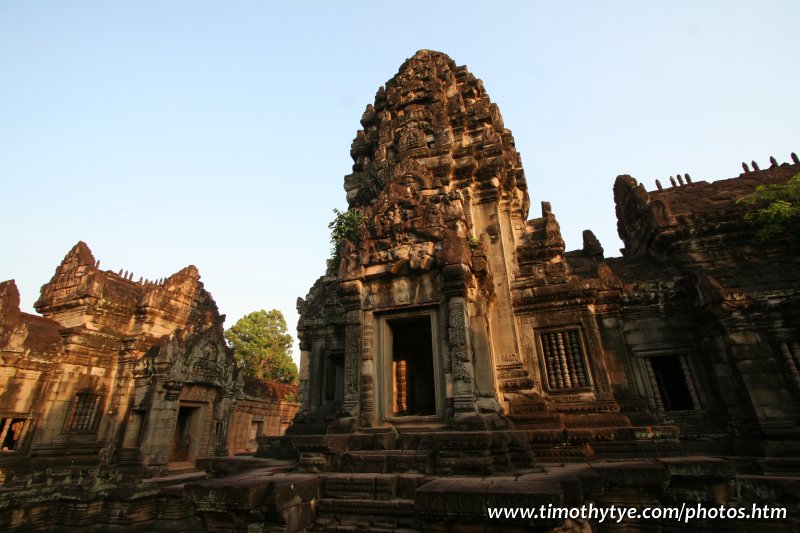 Banteay Samre (25 February, 2006)
Banteay Samre (25 February, 2006)
The king had no direct descendants, so his noblemen resorted to divine intervention. They sent out his white elephant. The elephant stopped in front of the Pou, and paid homage him him by lowering his trucnk between its feet and knelt. The noblemen took this as a sign, and enthroned Pou as king.
On becoming king, Pou exhumed the corpse of his predecessor and gave it a funeral ceremony at the East Mebon, followed by the rites of cremation at Pre Rup.
The new king, however, was facing difficulties in controlling his court dignitaries. Feeling humiliated at being governed by a lowly farmer, they expressed their discontent by refusing to show respect to him. Pou, feeling powerless to discipline them, left the Royal Palace and went to live in solitude at Banteay Samre. There, King Pou issue a decree to have all those who humiliated him beheaded. After that incident, his reign continued peacefully.
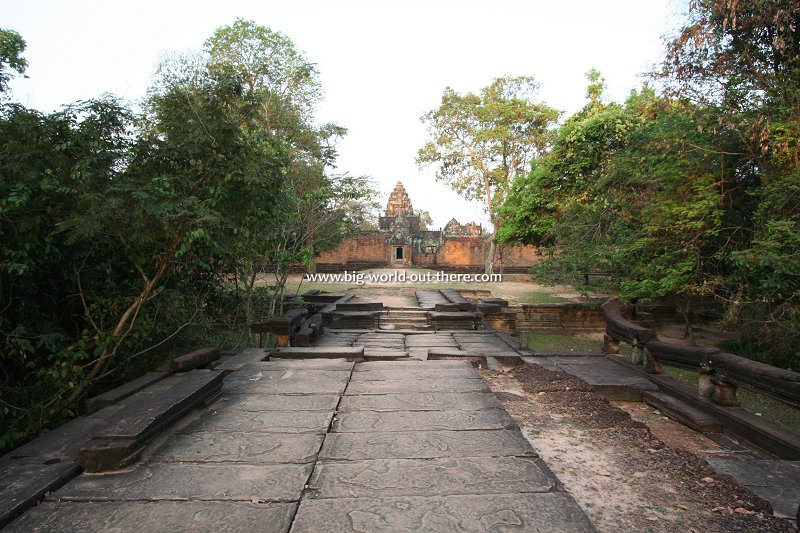 View of Banteay Samre from its causeway (25 February, 2006)
View of Banteay Samre from its causeway (25 February, 2006)
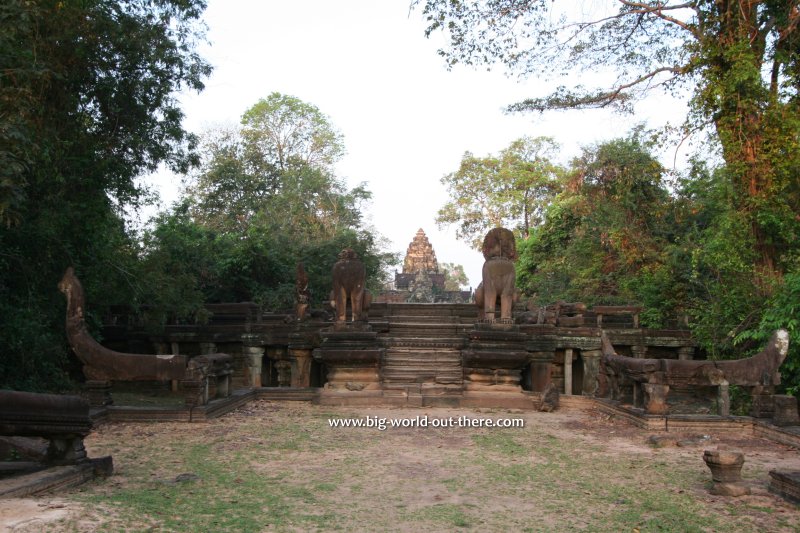 Guardian lions at the stairs leading up to the causeway of Banteay Samre (25 February, 2006)
Guardian lions at the stairs leading up to the causeway of Banteay Samre (25 February, 2006)
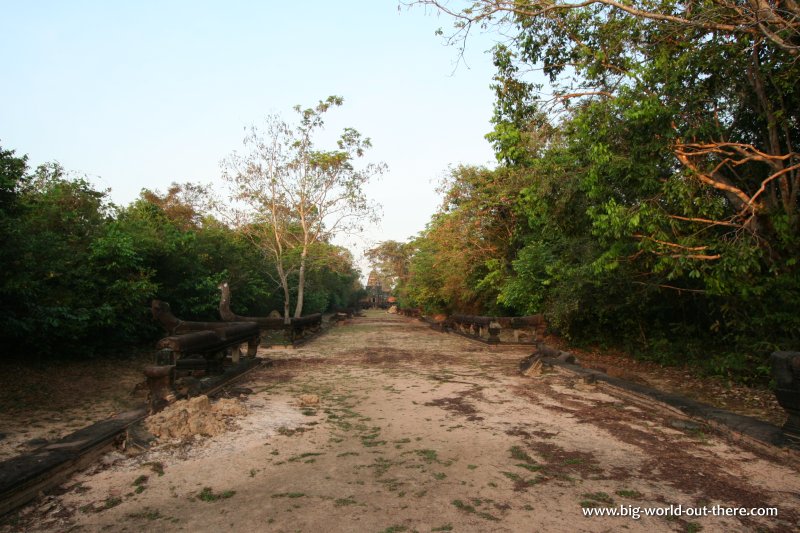 The causeway towards Banteay Samre (25 February, 2006)
The causeway towards Banteay Samre (25 February, 2006)
When Banteay Samre was discovered, it was overrun with vegetation. Restorers using anastylosis - a restoration process of dismantling, reassembling and replacing vital lost pieces - has brought out the beauty of Banteay Samre. When I visited it with Chooi Yoke, we found that the temple was very well kept. The lawns were neat and tidy, and there were workers upkeeping the place.
I learned that Banteay Samre was restored after a similar project was carried out on the much smaller (but perhaps even more exquisite) Banteay Srei. The knowledge and experience gained from the Banteay Srei project provided restorers the confidence to execute the task.
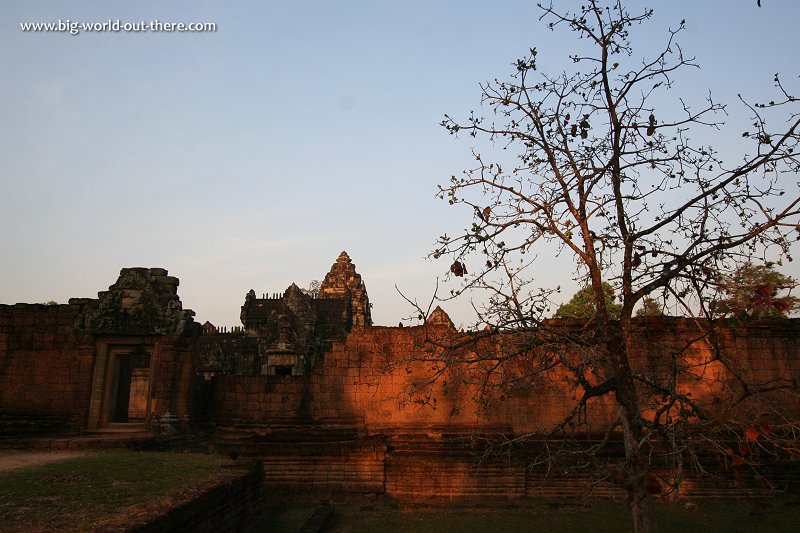 The outer wall of Banteay Samre (25 February, 2006)
The outer wall of Banteay Samre (25 February, 2006)
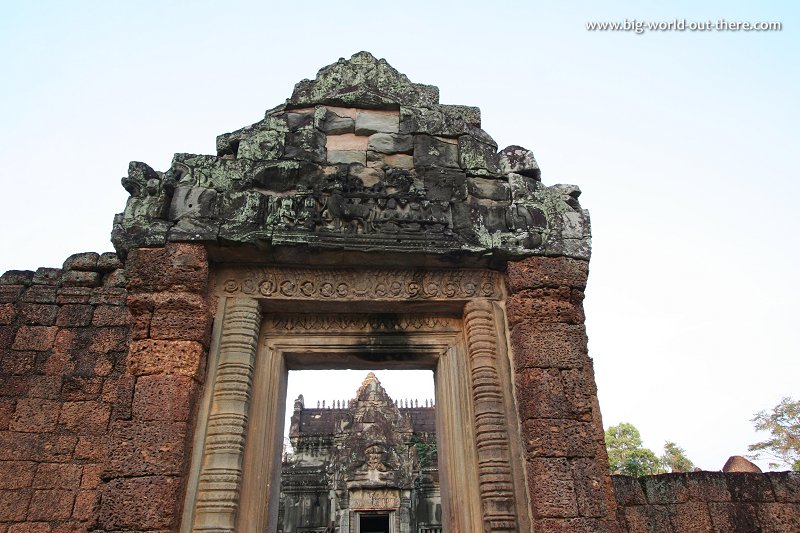 Lintel at an entrance to Banteay Samre (25 February, 2006)
Lintel at an entrance to Banteay Samre (25 February, 2006)
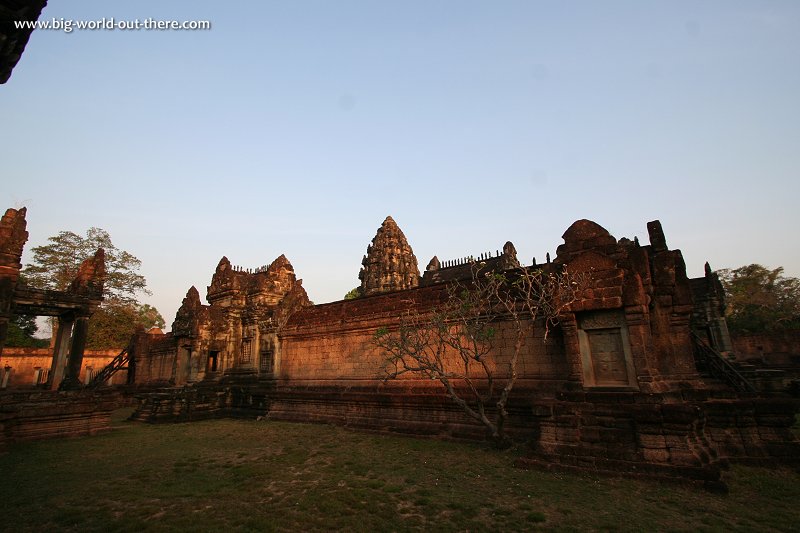 Compound of Banteay Samre (25 February, 2006)
Compound of Banteay Samre (25 February, 2006)
No inscription was found on Banteay Samre to accurately pinpoint its construction date. Nevertheless, judging from the style of its construction, Banteay Samre is believed to have been built around the time of Angkor Wat, that is, towards the middle of the 12th century.
Banteay Samre consists of an outer wall with four gopuras enclosing a courtyard. Raised within the courtyard is the second enclosure. There is an east and a west inner gopura that links to the gopuras of the outer wall. Steps lead steeply from the outer wall to the central courtyard. There is an seconde courtyard within the second enclosure. Detached within this inner courtyard are two structures which restorers called the "Libraries". And then, right in the middle of the whole complex, is the Central Sanctuary. I think trying to explain in words sounds rather confusing.
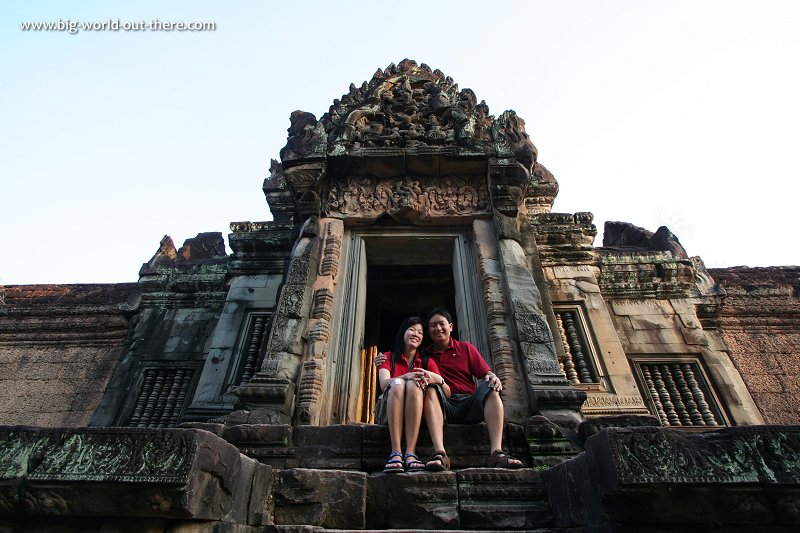 My wife and I at Banteay Samre (25 February, 2006)
My wife and I at Banteay Samre (25 February, 2006)
My Visit to Banteay Samre
Of the three trips that I made to Angkor, I only visited Banteay Samre on my second tour. During my first trip, our guide said that the road to Banteay Samre was too soggy to reach (we had made the trip during a wet month). I returned on a subsequent visit during the dry month, and was able to pay Banteay Samre a visit. I did not return to it on my third and final trip to Angkor, as we didn't have time to reach it, and members of my group was already suffering from "stone fatigue".I arrived at Banteay Samre with my wife quite early in the morning, driven there by our tuk tuk driver Mr Han. The road took me to the northern side of the monument. From there, we walked to the main entrance to the east. At the east is a 200 metre causeway with naga balustrades and stone lions at regular intervals. I walked the whole length of the causeway to have a feel of its size. The pools on both sides of it have long gone.
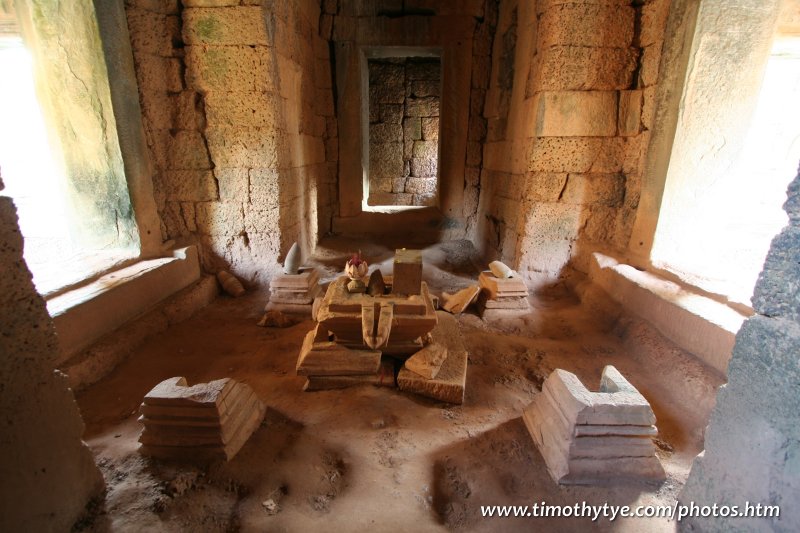 The interior of Banteay Samre (25 February, 2006)
The interior of Banteay Samre (25 February, 2006)
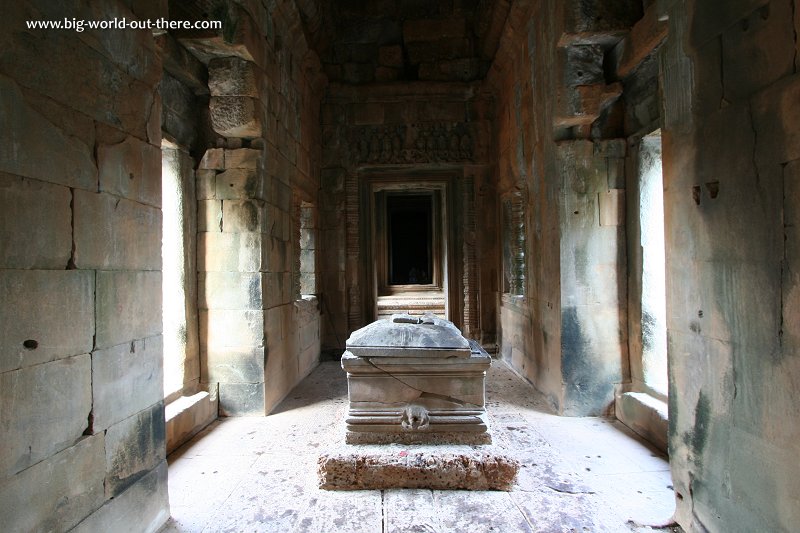 A pedestal for the yoni and the missing lingga at Banteay Samre (25 February, 2006)
A pedestal for the yoni and the missing lingga at Banteay Samre (25 February, 2006)
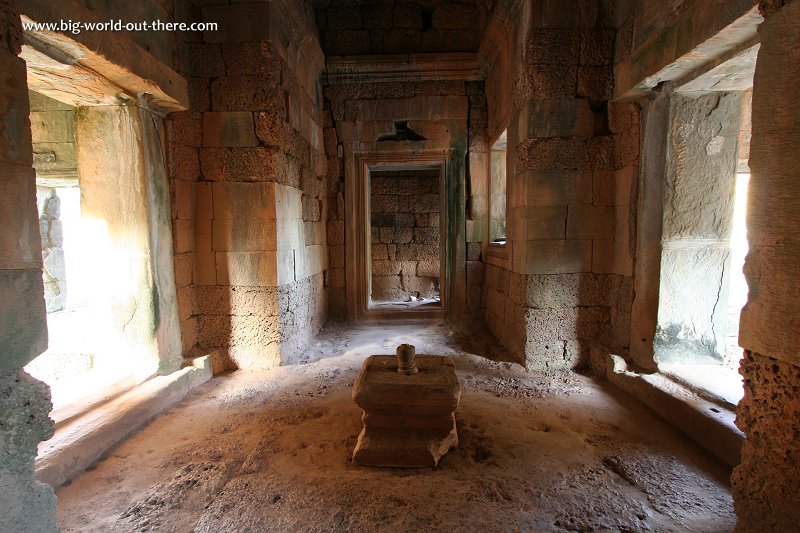 Another pedestal at Banteay Samre, with what appears to be a substitute for a lingga. (25 February, 2006)
Another pedestal at Banteay Samre, with what appears to be a substitute for a lingga. (25 February, 2006)
After causeway, we entered the outer enclosure. I walked around to get a proper angle. It was still early morning and the sun had jus risen, bathing the monument in a rich vermillion. I observed that the north, west and south gopuras are of similar design. They are cruciform in plan, and have two wings connected to the galleries as well as two porticoed doors.
As I walked around Banteay Samre, it appears so similar to Angkor Wat, but only at a reduced scale. Even the prasats, or towers, are similar to those at Angkor Wat, and if I may add, those at Banteay Samre appear in a better degree of preservation.
The tympanums on the porticoes are often ornately sculptured. I learn that the best preserved panel, also one of the finest in Khmer art, is found on the north gopura northern side. (I must say I didn't see it, as it was against the light at the time of my visit). Drawn from the Ramayana epic, it depicted the fight between Rama and Ravana, each on their respective chariots.
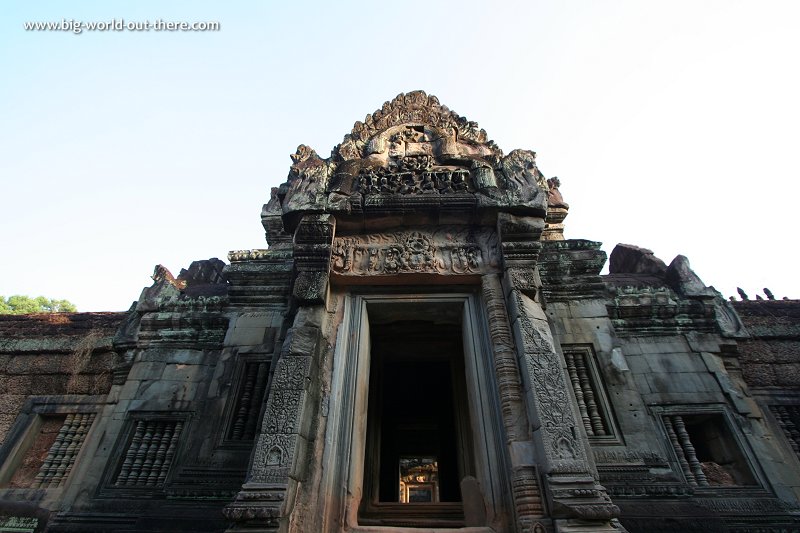 Doorway with carved lintel and pediment at Banteay Samre. (25 February, 2006)
Doorway with carved lintel and pediment at Banteay Samre. (25 February, 2006)
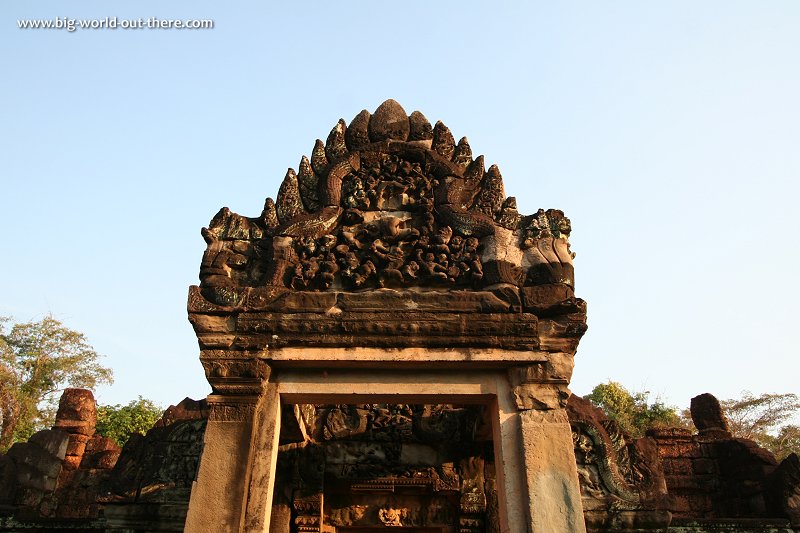 Pediment and lintel of an entrance at Banteay Samre. (25 February, 2006)
Pediment and lintel of an entrance at Banteay Samre. (25 February, 2006)
Banteay Samre is not the most popular monument in Angkor, which is a shame because it is an exquisite example of Khmer art. Owning perhaps to its distance, not many people have been to it. Nevertheless, I would encourage AsiaExplorers members who have read my description here to attempt visiting it should they be Angkor.
How to reach Banteay Samre
To get to Banteay Samre, turn right somewhere between Pre Rup and East Mebon, about 14km from Siem Reap. (I think there is a signpost - if you're passing that way, can you verify for me?) After that, go straight on the road between Pre Rup and the eastern Mebon. The road will pass a small Cambodian village (the name of the village is Pradak). Here, you see a T-junction to the left. The left turn takes you to Banteay Srei. Don't turn left, but continue straight on for another 2 km or so, and you arrive at a right run dirt road. This road takes you to the northern entrance of Banteay Samre.If you need tuk tuk, you can call my tuk tuk driver Mr Han (contact below) to see if he is available to take you there.
 Latest updates on Penang Travel Tips
Latest updates on Penang Travel Tips
 Map of Roads in Penang
Map of Roads in Penang
Looking for information on Penang? Use this Map of Roads in Penang to zoom in on information about Penang, brought to you road by road.
Copyright © 2003-2025 Timothy Tye. All Rights Reserved.

 Go Back
Go Back